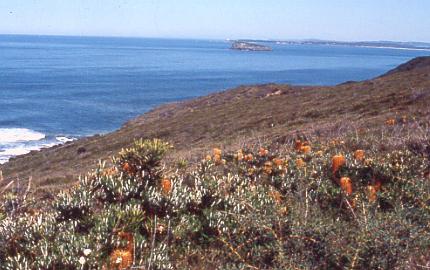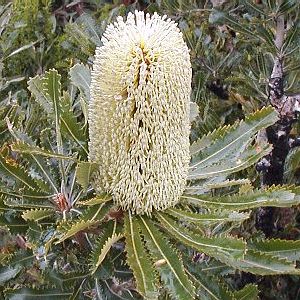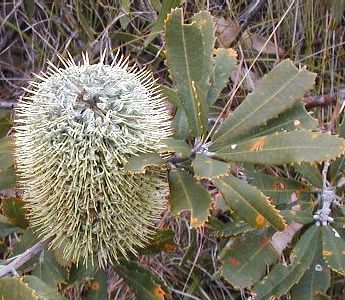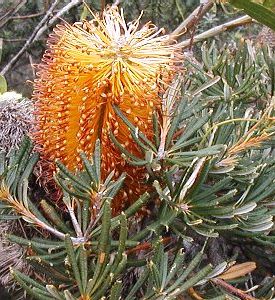|
[Front Page] [Features] [Departments] [Society Home] [Subscribe]

Coastal Wanderings
Cas Liber
 |
|
Coastal heath with Banksia spinulosa at Wybung Head
|
|
Last winter, I was shown around a spectacular area for east coast wildflowers by two members of the Newcastle District Group of the Australian Plants Society, Barbara Burke and Angela Speering.
Approximately 100km north of Sydney is Lake Munmorah Conservation (previously Recreation) Area, now protected under the auspices of the National Parks and Wildlife Service. Another 10 or so km north of this is a small township of Catherine Hill Bay, the hill on Flowers Drive to the north of the town having some wonderful heathland to explore on either side of the road.
Much of the heathland is low growing (10-50cm) shrubs with occasional 1 metre Westringia fruticosa and Banksia integrifolia var. integrifolia. Interspersed with grasses are low growing forms of Banksia spinulosa var. collina ranging from 40cm to 1m high, with a variety of colour forms; gold inflorescences 10-15cm high with gold, red, maroon, black and even pink styles all to be found within a few metres of each other. They have wonderfully compact foliage with serrated leaves, though some of the darker styled plants seem to have more revolute leaves, suggesting some influence of B.spinulosa var. spinulosa which occurs further south. Interstingly, the garden plant B.spinulosa 'Stumpy Gold' came from this area many years ago, a boon for anyone on the Central Coast wishing to grow both an indigenous and horticultural plant.
 |
|
 |
Banksia aemula in late bud (left)
Banksia oblongifolia (right)
Photos: Cas Liber |
Of similar appeal is a dense low growing form of Lambertia formosa - one seen was a spectacular dense cushion 10cm high by around 40cm across which resembled some natural topiary. The leaves are elliptic and 1 to 1.5cm long by about 3mm wide with a midline spike. A few flowers were seen on these plants.
Scattered about also were low forms of Isopogon anemonifolius and Hakea laevipes (this lignotuberous plant was previously included under the nonlignotuberous and taller growing Hakea dactyloides - dagger hakea - but split off in the recent botanical revision). The name comes from the latin for 'fat foot' in reference to the lignotuber. Volume 17B of The Flora of Australia states that it flowers in November-January; certainly none was flowering when I was there.
Other hakeas included a lowish form of Hakea teretifolia up to 1m, and Hakea bakeriana, up to 1.5m with scattered deep pink flowers partly hidden in the lime green foliage.
There was also a shrubby Dodonaea triquetra forming a rounded bush to 1m. Also in flower was a fairly compact form of Logania albiflora, a plant with small white flowers with a great scent. Twining around was a form of Pandorea pandorana with white flowers tinted with maroon, which was most attractive.
 |
|
A form of Banksia spinulosa with pink styles
Photo: Cas Liber |
|
Underneath the westringias and also forming mats out in the open was a fully prostrate Acacia myrtifolia with distinctive red stems and small lanceolate leaves. Flowering equally well whether shaded or in sun, it grew to maybe 30cm across. We also noted a prostrate Mirbelia rubiifolia. I must come back in late spring to try and catch this in flower (it is a pea with pink flowers). Also there were mats of Astroloma humifusum.
Widespread too, around 100m further inland, were stands of hundreds of plants of Banksia oblongifolia forming groves of natural bonsai a uniform 1m tall and wide. Scattered plants sported inflorescences in late bud or fully open, with an unusual green-blue (aqua?) tinge.
At Wybung Head in Lake Munmorah Conservation Area, there was a colony of low growing Banksia aemula shrubs which ranged from 0.7-1.5m high. A couple of plants forgot it wasn't summer/autumn and provided some nice greenish yellow inflorescences in late bud to photograph. Nearby there was a great display of flowers in white (Ricinocarpos pinifolius and Pimelea linifolia), various shades of pink (Eriostemon australasius), blue (Dampiera stricta) and yellow (Dillwynia retorta and probably some other peas).
To get there from Sydney, one drives north on the Sydney-Newcastle Freeway until the Doyalson Interchange and then drive on the Pacific Highway. Both Elizabeth Bay Drive (to Lake Munmorah) and Flowers Drive (to Catherine Hill Bay) run right off the Highway. I would regard this as a great place to visit near Sydney for anyone interested in seeing wildflowers (which I presume is most people reading this!).
Self-confessed 'Banksia Nut', Cas Liber, spends most of his time accumulating data about species, forms and cultivars of this iconic genus of Australian native plants.
Not surprisingly, Cas is leader of ASGAP's Banksia Study Group.

[Front Page] [Features] [Departments] [Society Home] [Subscribe]
Australian Plants online - December 2003
Association of Societies for Growing Australian Plants
|